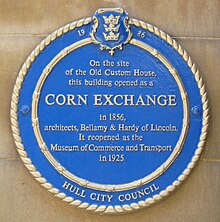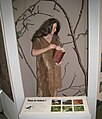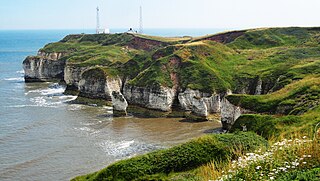
The East Riding of Yorkshire, often abbreviated to the East Riding or East Yorkshire, is a ceremonial county in the Yorkshire and the Humber region of England. It borders North Yorkshire to the north and west, South Yorkshire to the south-west, and Lincolnshire to the south across the Humber Estuary. The city of Kingston upon Hull is the largest settlement.

Folkton is a small village and civil parish at the foot of the Yorkshire Wolds and on the edge of the Vale of Pickering on an area known as Folkton Carr in North Yorkshire, England.

North Ferriby is a village and civil parish in the Haltemprice area of the East Riding of Yorkshire, England.

Brough is a town in the East Riding of Yorkshire, England. It is part of the civil parish of Elloughton-cum-Brough with the neighbouring village of Elloughton. Brough is situated on the northern bank of the Humber Estuary, approximately 12 miles (19 km) west of Hull city centre. Brough has a long association with BAE Systems. It was recently recognised as one of the most desirable places to live in Yorkshire, with a rising affluent population and a growing reputation for prestige, quality of life, and thriving communities such as Elloughton-Cum-Brough In Bloom.

Brantingham is a village and civil parish in the East Riding of Yorkshire, England, about 2 miles (3 km) north of Brough, 12 miles (19 km) west of Hull and north of the A63 road. The 2011 UK Census gave the parish had a population of 370, marking a decrease from the 2001 UK census figure of 410. The 2019 estimate was 319.
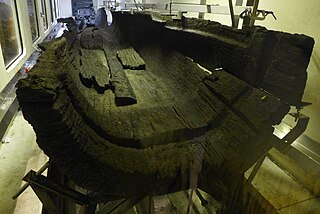
Hasholme logboat is an Iron Age boat discovered at Hasholme, an area of civil parish of Holme-on-Spalding-Moor in the East Riding of the English county of Yorkshire. It is now on display in the Hull and East Riding Museum, in Hull.

The Ferriby Boats are three Bronze-Age British sewn plank-built boats, parts of which were discovered at North Ferriby in the East Riding of the English county of Yorkshire. Only a small number of boats of a similar period have been found in Britain and the Ferriby examples are the earliest known sewn-plank boats found in Europe, as well as the oldest known sewn-plank boats in the world outside of Egypt.
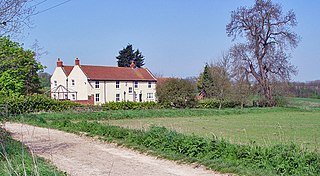
Wauldby is a region in the Yorkshire Wolds within the civil parish of Welton in the East Riding of Yorkshire, England. It contains the gentrified hamlet around Wauldby Manor Farm, and a few other minor dwellings including Little Wauldby Farm.

The Parisi were a British Celtic tribe located somewhere within the present-day East Riding of Yorkshire, in England, known from a single brief reference by Ptolemy in his Geographica of about AD 150. Many writers have connected them with the archaeological Arras culture and some with the more widely known Parisii of Gaul.

The Dover Bronze Age boat is one of fewer than 20 Bronze Age boats so far found in Britain. It dates to 1575–1520 BC, which may make it one of the oldest substantially intact boat in the world – though much older ships exist, such as the Khufu ship from 2500 BC. The boat was made using oak planks sewn together with yew lashings. This technique has a long tradition of use in British prehistory; the oldest known examples are the narrower Ferriby boats from east Yorkshire. A 9.5m long section of the boat is on display at Dover Museum.

The Hull Maritime Museum is a museum in Kingston upon Hull, England, that explores the seafaring heritage of the city and its environs. The museum's stated mission is "To preserve and make available the maritime history of Hull and east Yorkshire through artefacts and documents".
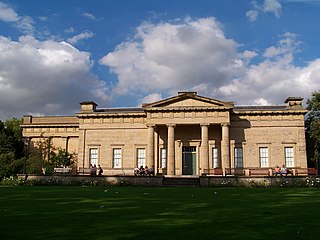
The Yorkshire Museum is a museum in York, England. It was opened in 1830, and has five permanent collections, covering biology, geology, archaeology, numismatics and astronomy.
Petuaria was originally a Roman fort situated where the town of Brough in the East Riding of Yorkshire now stands. Petuaria means something like 'quarter' or 'fourth part', incorporating the archaic Brythonic *petuar, 'four'.
The East Riding of Yorkshire is a local government district with unitary authority status, and is a ceremonial county of England. It is named after the historic East Riding of Yorkshire which was one of three ridings alongside the North Riding and West Riding, which were constituent parts a Yorkshire ceremonial and administrative county until 1974. From 1974 to 1996 the area of the modern East Riding of Yorkshire constituted the northern part of Humberside.

Anlaby Road is a major arterial road and residential district in west Hull, East Riding of Yorkshire in the north of England. It runs west from the city centre to the city boundary, designated A1105 to its junction with Boothferry Road and then B1231 from there to the city boundary.

Thomas Sheppard was a British museum curator and amateur geologist, who founded several museums in Kingston upon Hull and in the East Riding of Yorkshire, England.

Rudston Roman villa is a Roman villa and scheduled monument near Rudston, East Riding of Yorkshire.
Brantingham Roman villa is a Roman villa, now a scheduled monument, near Brantingham, East Riding of Yorkshire, England.

The Roos Carr figures are a group of prehistoric wooden figurines found at Roos Carr, near Withernsea in the East Riding of Yorkshire, England, in 1836.


